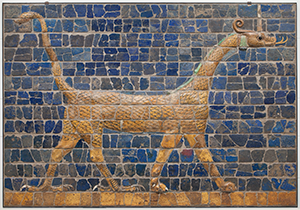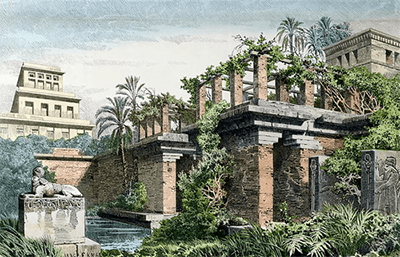Ancient Babylon
Babylon began as a small settlement, forming nothing so much as an administrative role in the reign of Sargon, the world's first emperor. The settlement grew and came into its own as a center of great power with the advent of the Amorite leader Hammurabi, who first reigned over the city in 1792 B.C. and spent the next three decades conquering all of Mesopotamia. It was this king, whose name has come down to future generations largely because of his famous law code, who named his domain the Babylonian Empire. Hammurabi spent much time focused on Babylon itself, ordering built large temples and reinforcing the walls surrounding the proud city, which became the largest and most well-known city in the world. Hammurabi died in 1750 B.C., and his son, Samsu-Iluna, had little of his father's talent for warfare, politics, or administration. At the same time, neighbors like the Assyrians and Hittites had expanded their weaponry and manpower. Subsequent Amorite leaders fared little better, although the civilization held on to power, even if tenuously. The Hittite leader Mursilli I sacked Babylon in 1595 B.C. In the continual cascade that marked the history of the Fertile Crescent, the Hittites faded from view as another power, the Kassites grew. These people took control of Babylon and the surrounding area in and gave the metropolis a new name, Karanduniash. The powerful Kassites conquered all of Mesopotamia and ruled it for a handful of centuries. The first cracks in Kassite rule appeared in 1235 B.C., when an Assyrian king named Tukulti-Ninurta I captured Babylon and took the throne. The Kassites hung on to the bulk of their holdings for another 80 years before losing control for good in 1160 B.C. The nominal ruler of Babylon at this time was part of the fading Akkadian tradition, but the power behind the throne was the Assyrian Empire, which controlled Babylon and a large part of the rest of Mesopotamia for a handful of centuries. One Assyrian king, Sennacherib, had had enough of a bubbling rebellion in Babylon and ordered the city not only sacked but razed, in 689 B.C. His order so appalled many people in Mesopotamia that he fell victim to assassination by his own sons, who then set about rebuilding the ancient citadel. Six decades later, when the city was yet again a center of commerce and culture, a new strongman arrived on the scene. Nabopolassar of Chaldea claimed the city and the throne in 625 B.C. Flush with success, this king made an alliance with the neighboring Medes and took on Assyria itself. In 612 B.C., the Chaldean-Mede alliance completed a three-month siege by capturing the Assyrian stronghold of Nineveh and destroying it. Assyria faded from the scene.
Babylon carried on, ruled in turn by Nebuchadnezzar II beginning in 605 B.C. On the throne for four decades, this Chaldean leader of the Babylonian Empire was one of the most famous names in antiquity. He is known in the Christian and Jewish traditions as the ruler who destroyed Jerusalem and consigned thousands of Jews to the Babylonian Captivity. He is also known for ordering built, for his wife, the Hanging Gardens, one of the Seven Ancient Wonders of the World. Among his other accomplishments was the building of the famous Ishtar Gate–with its blue tiles and exotic depictions of bulls and dragons–and the expansion of the city walls to three 40-foot-tall rings. Also associated with the city of Babylon is the Tower of Babel, which many historians associated with a ziggurat built to honor the god Marduk. That god was also the focal point of a 280-foot-tall shrine named Esagil, also ordered built by Nebuchadnezzar II. 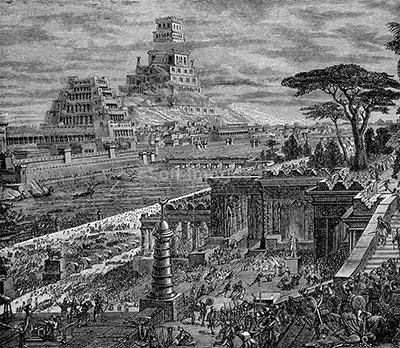
As was the case with Hammurabi, a strong hand was followed by a series of weaker ones. Nebuchadnezzar II gave way to a number of less capable rulers, and the Babylonian Empire was again ripe for takeover. The aggressor this time was Cyrus the Great, founder of the Persian Empire. Babylon Cyrus conquered not by force but by nonviolent strategy. The king of Babylonia at the time, Nabonidus, was unpopular with his own people. Cyrus let it be known far and wide that he would certainly be the better choice as a ruler and that he would govern not as a conqueror, destroying the traditions of the conquered, but as a benevolent father figure, allowing the local people to continue their religious and other traditions as long as they revered him and paid tribute to him. It didn't hurt that Cyrus arrived in Babylon at the head of a large army after diverting the Euphrates River and using a national ceremony as cover for what turned out to be a peaceful occupation. 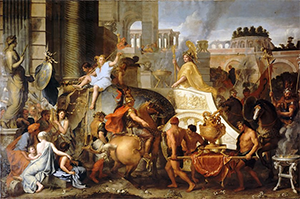
From that point forward, for several centuries, Babylon was just one of a number of important cities in the Persian realm. A succession of emperors ruled Babylon for two centuries, until the advent of Alexander the Great, who took Babylon in 331 B.C., on his way further east. He died there eight years later. In the power vacuum that followed, one of his generals became Seleucus I, head of his own empire. This leader neglected Babylon in favor of his new capital, Seleucia; in fact, he ordered large amounts of stone and wood carted off from Babylon in order to use in the new capital. The last power of antiquity to claim Babylon was the Parthian Empire, in 141 B.C. |
|
Social Studies for Kids
copyright 2002–2025
David White



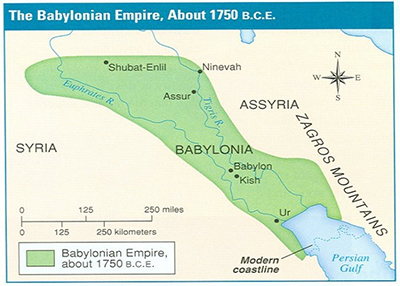 The city of Babylon is one of the ancient world's most famous, the center of a succession of empires, the home to one of the Seven Ancient Wonders of the World, and the city in which one of antiquity's greatest conquerors breathed his last.
The city of Babylon is one of the ancient world's most famous, the center of a succession of empires, the home to one of the Seven Ancient Wonders of the World, and the city in which one of antiquity's greatest conquerors breathed his last.